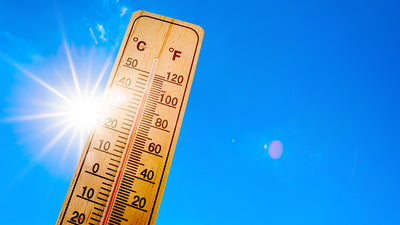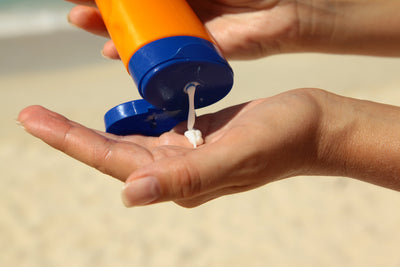Water Quality InformationWritten By Actual Experts
RSSHere’s Why You Shouldn’t Drink or Cook With Water From the Hot Water Side of Your Faucet

Health Effects Caused by Exposure to PFAS Chemicals

How Does Climate Change Impact Drinking Water?

Emily Driehaus | Science Communication Intern
Recent IPCC reports provided a look into how climate change has altered global temperatures and weather patterns over the past few decades. The International Panel on Climate Change publishes a "state of climate change" every few years that provides update on how today’s emissions and activities will affect weather patterns in the future, and the effects these changes will have on our lives. The report highlighted how climate change has and will continue to impact the accessibility of clean drinking water.
Why This IPCC Report is Different From Previous Years:
The recent IPCC findings are notable because scientists have determined that it is “unequivocal that human influence has warmed the atmosphere, ocean and land.” The term “unequivocal” is not used lightly in this instance, as scientists do not use absolutes unless the evidence is unquestionable.
Scientists also used paleoclimate data to provide more context for our current period of warming. Our planet goes through glacial and interglacial periods, where a glacial event is followed by a period of time where the climate is warmer. We are currently in an interglacial period after the last glacial period ended about 11,000 years ago. The last interglacial period before our current interglacial occurred about 125,000 years ago. The IPCC report found that “the last decade was more likely than not warmer than any multi-centennial period after the Last Interglacial.” To put this in perspective, Homo sapiens were still mostly living on the African continent 125,000 years ago. The past decade has likely been warmer than any multi-centennial period since Homo sapiens migrated out of Africa and dispersed across the globe.
The IPCC report also included new advances in a branch of climate science known as attribution science. Scientists can now attribute specific weather events to human-induced climate change. In other words, the frequency of extreme weather events, like droughts and hurricanes, is a direct result of human-driven climate change.
The authors of the report included a glimpse of what the future might look like under five different climate scenarios with greenhouse gas emissions ranging from “very low” levels to “very high” levels. Some effects of climate change are now unavoidable and are present in all scenarios, but the intensity of these events is increased as greenhouse gas emissions climb. For example, global surface temperatures will continue to increase in all the presented scenarios, but the degree of warming increases with each climate scenario. Global warming of 2° Celsius is very likely to occur under the “very high” emissions scenario, but is extremely unlikely to be exceeded under the “very low” emissions scenario. These scenarios provide important perspectives on what the future of our planet could look like under different emissions scenarios, as changes in weather patterns will become more extreme with each increment of warming.
What Does All This Have To Do With Drinking Water?
Extreme weather events already have an impact on our drinking water. Droughts reduce the amount of drinking water available due to the lack of precipitation to replace water supplies. Water contamination is also more likely to occur in areas with drought conditions. Hurricanes and tropical storms can also contaminate drinking water supplies with floodwater and leave communities without clean drinking water for long periods of time. Even cold weather events can affect access to clean drinking water, especially in areas that are not equipped with the infrastructure to deal with extremely cold temperatures. For example, the recent round of winter storms that brought freezing temperatures to Texas limited access to drinking water due to frozen pipes, power outages, and boil water advisories.
As global temperatures increase, these extreme weather events will increase not only in frequency but in intensity as well. Drinking water supplies will be threatened by these events more often and the intensity of these events risks damaging water infrastructure that was not built to withstand the extreme weather conditions created by climate change.
The IPCC report also included specifics on how global warming will directly impact the global water cycle. Like weather patterns, the rise of global temperatures will intensify the water cycle, making wet seasons wetter and dry seasons drier. This will have direct implications for areas of the world that depend on seasonal precipitation. Intensified dry seasons will impact agriculture and those who depend on rainy seasons to water their crops. Intensified wet seasons bring the risk of flooding that could potentially damage communities and infrastructure. These intensified seasons will also bring problems with drinking water quality, either due to lack of rainfall to replenish water supplies or too much precipitation that contaminates drinking water supplies with dirty floodwater.
How Can We Stop The Worst From Happening?
It is easy to fall into a downward spiral of negative thinking after reading about how our planet is being irreversibly damaged. However, this report makes it clear that there is still time to change course. While it is too late to stop some warming from occurring, there is still time to cut greenhouse gas emissions and prevent the worst from happening. Now is the time to call on world leaders and governments to implement policies that will lower emissions and protect future generations and ensure a livable planet with access to clean drinking water for all.
Other Articles We Think You Might Enjoy:
How Do Droughts Affect Your Drinking Water?
How Do Hurricanes Affect Your Drinking Water?
Wildfires and Water Quality
PFAS Water Filters for New York State

Oxybenzone and Drinking Water

Emily Driehaus | Science Communication Intern
Oxybenzone is a common sunscreen ingredient that has been shown to have negative impacts on human health and the environment. Evidence has shown that it can contaminate drinking water after being washed down the drain while showering off sunscreen.
What is Oxybenzone?
Oxybenzone is a UV filter used in sunscreen and other cosmetics. It absorbs UV rays from the sun and helps prevent them from penetrating the skin and causing sun damage. While it does help protect our skin against the sun, it has implications for both our health and the environment, particularly aquatic life.
Oxybenzone and Marine Life
Much of the concern regarding oxybenzone began when researchers noticed damage to coral reefs near beaches with many visitors. As sunscreen gets sloughed off the skin by the water and sand, it can make its way into the ocean and harm aquatic life. Coral reefs are especially susceptible to damage, as oxybenzone can harm normal growth and development, damage DNA and put them at an increased risk of bleaching.
Health Implications of Oxybenzone
As research into oxybenzone has continued, it has been designated as an endocrine disruptor. Endocrine disruptors interfere with normal hormonal processes in the body and can impact the reproductive system. Most research on oxybenzone in the human body has focused on absorption through the skin rather than ingestion, but more evidence has shown that oxybenzone is present in drinking water, especially in communities near large bodies of water.
How Does Oxybenzone Get Into Drinking Water?
After a day at the beach, most individuals hop in the shower to rinse off the sunscreen and sand that has accumulated on their skin throughout the day. When this water goes down the drain, it goes to wastewater treatment plants to be treated before being released into water sources, which can be used for drinking water. Wastewater treatment plants and drinking water facilities lack the ability to filter out endocrine disruptors like oxybenzone, so it ends up in drinking water consumed by the public. A study looking at oxybenzone in Honolulu tap water showed that individuals consume between 0.8-1.2 micrograms of oxybenzone a day from drinking water. This concentration is not particularly harmful to fully grown adults, but can have a greater impact on children, infants and developing fetuses.
Regulations on Oxybenzone
The previously mentioned study was submitted as part of testimony on a bill that would ban the sale of sunscreens containing oxybenzone in the state of Hawaii. The bill passed in 2018 and went into effect at the beginning of this year. The city of Key West, Florida has also enacted a ban on sunscreens with oxybenzone in an effort to protect coral reefs. These bans are not without controversy, as skin damage from UV rays can lead to skin cancer and banning sunscreens with oxybenzone leaves individuals in these areas with one less form of sun protection.
What Should I Do if I’m Concerned About Oxybenzone in my Water?
Carbon water filters are able to filter out oxybenzone and other endocrine disruptors. Using sunscreen with ingredients like zinc oxide or titanium dioxide rather than oxybenzone can also reduce your overall exposure. Switching sunscreens will also help protect aquatic life when you swim in bodies of water like lakes or oceans.
Other Articles We Think You Might Enjoy:BPA and Phthalates: Are These Two Endocrine Disruptors in Your Water?
Trump's "Dirty Water Rule" to be Revised
Drinking Water Supplies Risk Contamination from Toxic Wastewater Ponds






